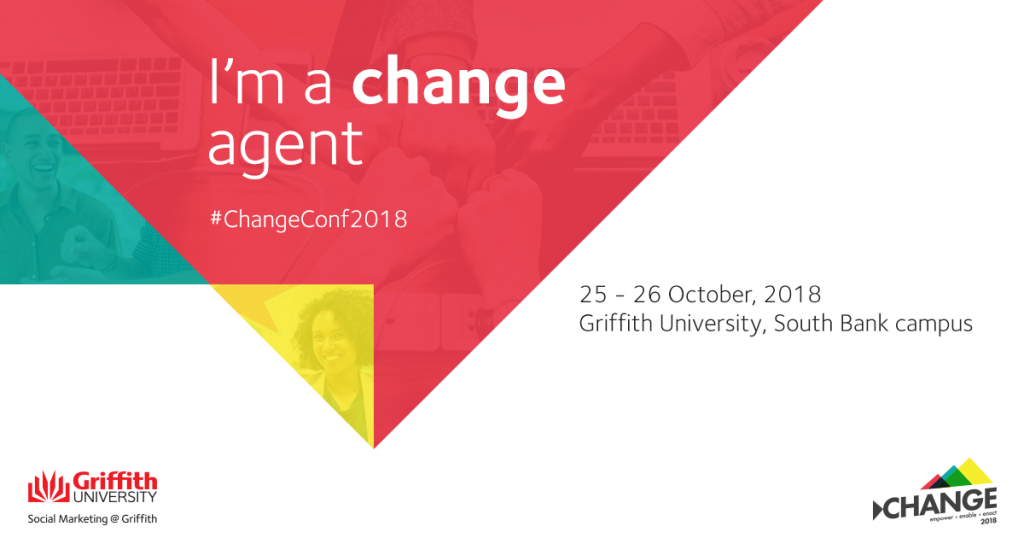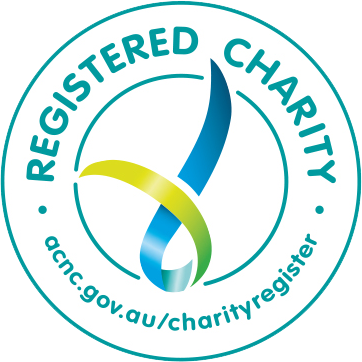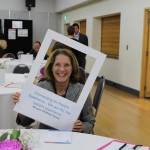By Pip Brennan, Health Consumers’ Council Executive Director
Change 2018 Conference, Griffith University
social marketing [is defined] as “the application of proven concepts and techniques drawn from the commercial sector to promote changes in diverse socially important behaviors such as drug use, smoking, sexual behavior… This marketing approach has an immense potential to affect major social problems if we can only learn how to harness its power.”
Andreasen A. Marketing social change. San Francisco, CA: Jossey-Bass, 1995.
What is social marketing? Why should we care?
The first time I heard Griffith University’s Sharyn Rundle-Thiele present on social marketing was in Perth, at Murdoch University. She was one of the guest speakers at an Australian Association of Social Marketing event presented by Perth-based social enterprise Marketing for Change. You may recall that Marketing for Change supported HCC to undertake community consultations for the Sustainable Health Review. The first thing that struck me as I waited for Sharyn’s session to begin was how different the audience was from my usual work-related presentations. There was not one WA Health Department staff member in the audience, but there were many local government agencies.
What also struck me about her presentation was not just how well-polished it was, but also how Sharyn was channeling and mobilizing among a new generation of students under her watch at Griffith a passion and capacity for co-designing social marketing messages with the very people the messages are designed to move.
The message that really landed for me in listening to Sharyn that day in Murdoch, was that the traditional preventative health leaflet will at best change behaviours for about 7% of those that read it. There was so much room for improvement, and the answer it seemed was not just better segmenting the message for those different audiences, but working with those audiences to make sure the messages land and wherever possible working beyond mere messaging to give people alternatives and not a message telling them what they ought to do.
As a consumer advocate who spends so much time trying to ensure the consumer voice is at the heart of our health service planning, this new world of public health messaging is a whole new frontier that consumer advocates needs to be aware of, and perhaps most importantly be taking a lead role in. It seems that there is a unified cry across Australia that more needs to be done in preventative health. Now it is up to consumers to ensure that preventative health is “done with” and not “done for” people.
Change 2018, Brisbane
This introduction to Social Marketing in Murdoch encouraged me to self-fund to attend a unique event at Griffith University – Change 2018. Over two days in October this year, I sat in a lecture theatre in Griffith University, a lone not for profit consumer advocacy professional in a sea of marketing professionals and consultants, academics, policy makers and government purchasers of social marketing.
I’m used to being the odd one out. I sat up the front and listened over two days, and as an outsider to the field, I took away some key insights to place social marketing squarely in the frame of a key tool to empower consumers in preventative health.
1. Social Marketing = Marketing for good
Some of the presenters were refugees from the world of commercial marketing. One noted that she threw in the towel as a marketer after she baulked at marketing alcohol to teenagers.
The reality is, we all know that marketing techniques work. What would it look like if we used these powerful tools for good?
2. Is there a problem? What actually is the problem?
The opening presentation by Professor Gerard Hastings used the story of the man whose lovely friendly Labrador dog turns up one day with the neighbour’s very dead rabbit in his mouth. This very neighbour is off on holiday and has charged the dog owner with looking after the garden, bringing in the mail etc. The very dead rabbit looks very much the worse for wear from the Labradors burying and digging up, so is washed and put back into his cage. When the neighhbour returns from holiday he is very thankful about the care and maintenance of the yard and post. He is just a bit surprised that the rabbit which had died just before they had left and had been buried in the back yard somehow magically appearing back in his cage. The point is, sometimes there is a strong belief there is a problem to be solved-but more informed research would have helped the Labrador owner to know there wasn’t a problem at all. This is one of marketing’s strengths – research that listens and learns in contrast to research asks and tells.
3. Marketing has many tools. Use them all!
Different presentations addressed the four Ps of traditional marketing (product, placement, promotion, price). A great case study was presented of a partnership project between a school and a local supermarket, which matched lessons for primary school students in diversifying the fruits and vegetables that families ate with low-priced produce which allowed the children to try different fruits and vegetables for themselves. The idea was that once the children had a chance to try the different tastes, they would continue to eat them, and meet the goal of diversifying the fresh foods that kids eat.
The point of this is – that while social marketing is most definitely not all about promotion, there are opportunities to consider how to use products, prices and placements to continue to nudge behaviours towards more positive, life-affirming ones.
Having said that, the key principle is that good social marketers work with end-users to identify the best intervention mix. Often, promotion isn’t even a part of it.
Nothing turns the curve in the regions like a community champion
The disconnect between policy makers in cities and the regional citizens they are hoping to influence can be enormous. A cane sugar farmer described how he personally had moved from a position of being vehemently opposed to any kind of change to the farming practices that had served his father and grandfather. It was the ability of the government representative to build a personal relationship, share the data about how less fertilizer and greater sugar yield would mean more profit for him, and a persistence to partner over the long haul as the successive crops proved the data right that helped create a community champion. The shift in attitude by this cane sugar farmer then caused a ripple effect that is continuing to extend across Queensland and into WA today.
Fear and statistics are popular with policy makers but don’t necessarily work…
Several presentations highlighted how government in particular are keen on social marketing campaigns which frighten people into better behaviour, and preferably include as many statistics as possible within the 3-minute advertisement. This can lead to a significant expenditure on campaigns which just don’t work.
Focus groups – are these on the nose?
Focus groups came under some criticism in terms of both their lack of diverse participants, and their tendency to ask people “what else would you like?” Being asked this open-ended question, and being in receipt of a nice morning tea and a voucher can lead people to feel they need to provide extra feedback which can dilute the social marketing message, creating a camel campaign doomed to failure.
Fundamentals of change
The closing address highlighted these key changes required to the way social marketers work:
• The focus needs to change from problem focused to solution-driven. Answers for many of the complex problems social marketers aim to tackle can be found at the community level. Sharing the problem with the general community as soon as possible will facilitate a solution focused approach
• Doing to vs doing with – the mantra “nothing about us without us” applies just as well in social marketing as it does on health consumer advocacy.
• Expert driven – to citizen led. Social marketers and other experts can never be experts in someone else’s world.
• Government driven – to on the ground/community led. No more fear-based, statistic-heavy expensive interventions!
• Solos to partnerships – thinking creatively about not for profit, government, academic and commercial partnerships can create a more effective campaign that leverages all the concepts of promotion product, preplacement and price.
Social Marketing and Preventative Health
I attended this conference because I thought there was something important on the horizon with our state’s likely increased focus on preventative health. I wanted to understand more about what social marketing could and should be for Western Australians. I left the conference more convinced than ever that this is a key tool to support creating a healthier society. As always, the key needs to be involving consumers from the beginning, and all the way through any initiative or campaign.

















